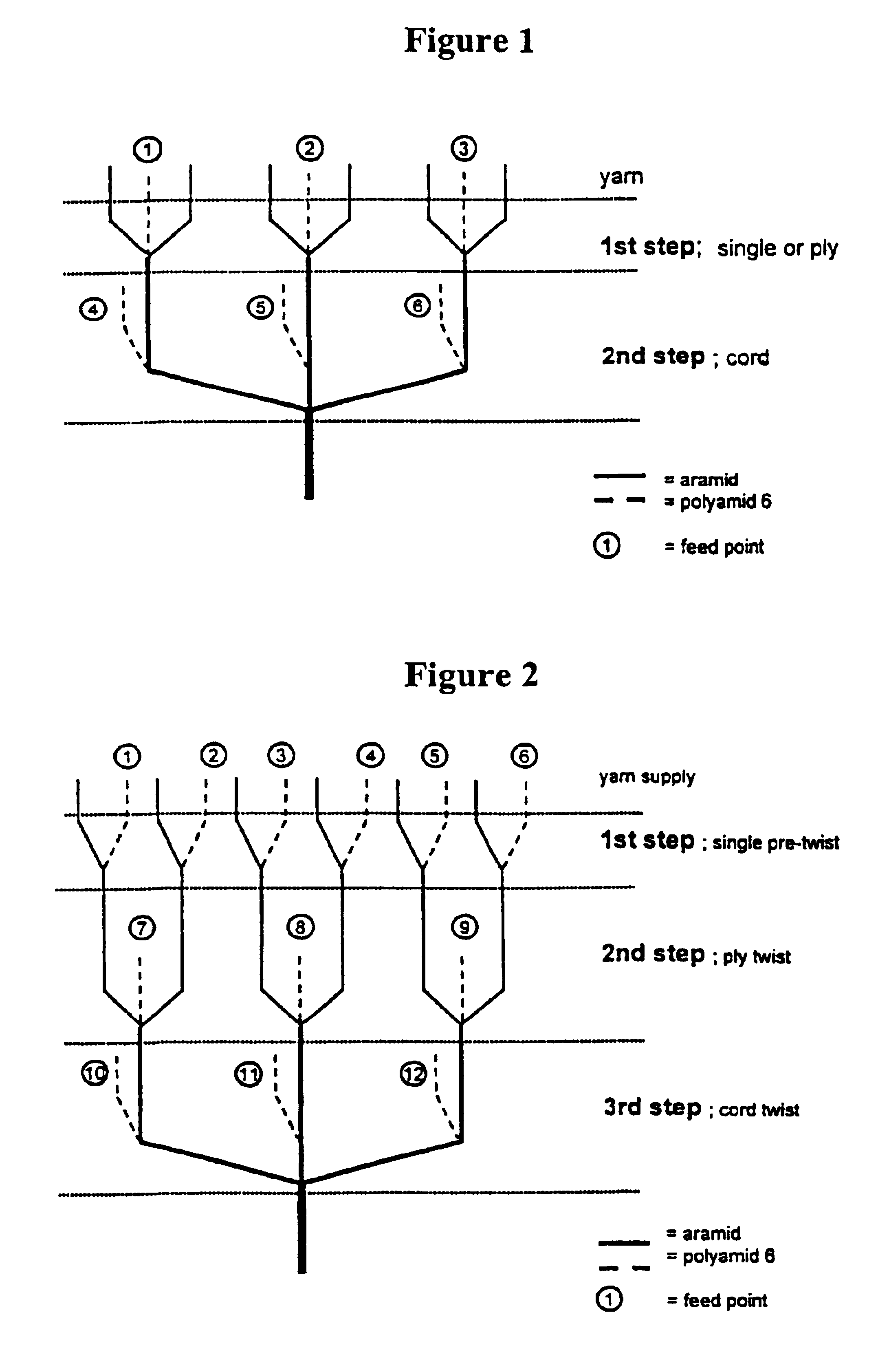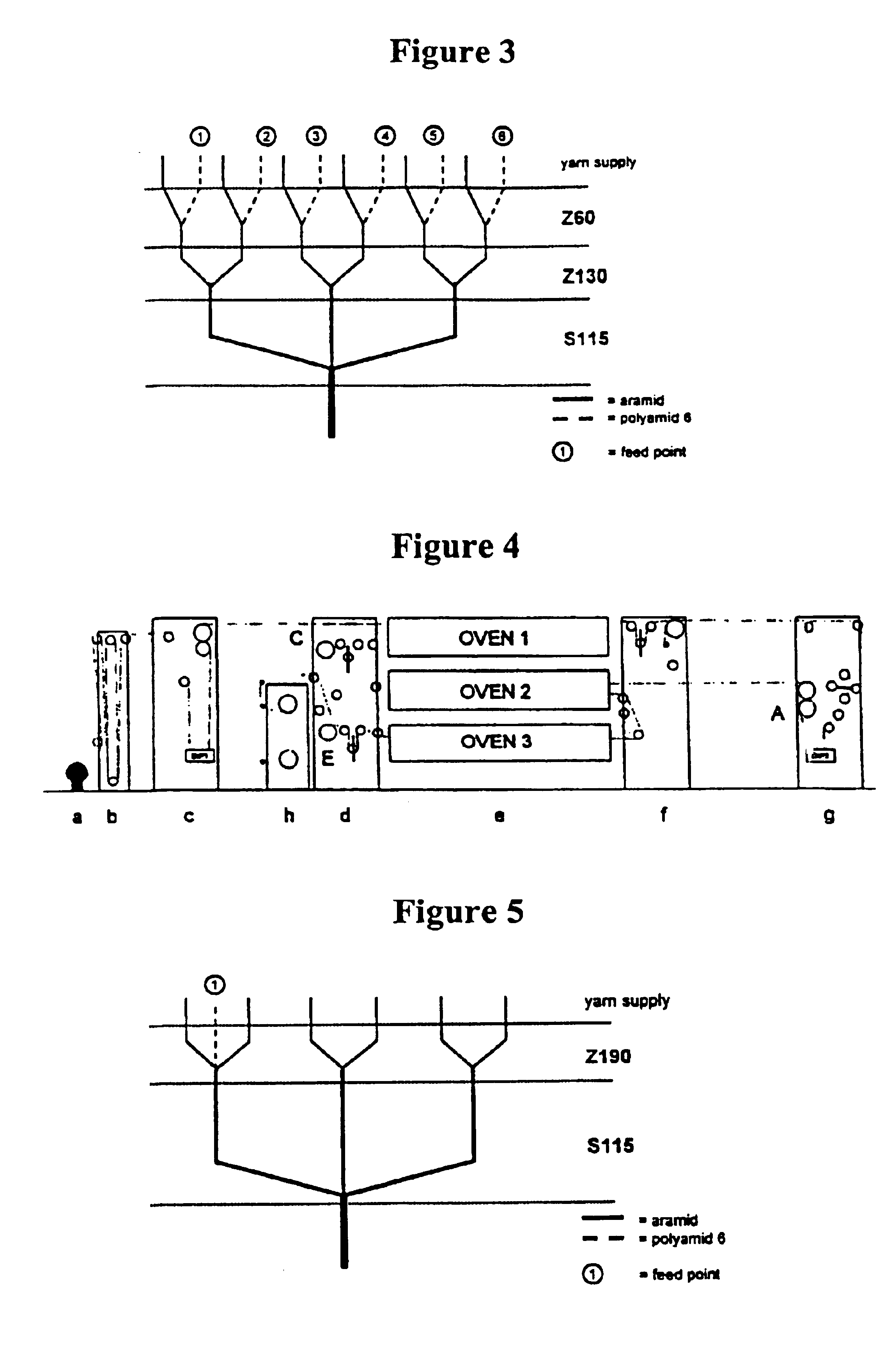Transmission belts comprising a cord with at least two fused yarns
a technology of fused yarn and transmission belt, which is applied in the direction of vehicular safety arrangments, pedestrian/occupant safety arrangements, other domestic objects, etc., can solve the problems of poor strength efficiency, stiff-dipped p-aramid cords suffering severe strength loss, and the mechanical properties of cords tend to deteriorate, so as to achieve good adhesion, high bundle cohesion, and high strength efficiency
- Summary
- Abstract
- Description
- Claims
- Application Information
AI Technical Summary
Benefits of technology
Problems solved by technology
Method used
Image
Examples
example 1
Dipping Conditions
[0036]For a typical aramid construction for transmission belt application the following dipping conditions are chosen.
[0037]
Two-bath procedure:Pre dipping conditions.dip:T03 (2%) GE100 epoxideoven 1residence time:120 sectemperature:150° C.tension:25 NRFL dipping conditionsdip:VP latex A11 (25%)oven 2residence time:120 sectemperature:150° C.tension:25 Noven 3residence time: 60 sectemperature:235° C.tension:25 NOne-bath procedure:RFL dipping conditionsdip:VP latex A11 (25%)oven 1residence time:120 sectemperature:150° C.tension:25 Noven 2residence time: 60 sectemperature:235° C.tension:25 N
[0038]The dip treatment was carried out on a Lizler laboratory dipping unit according to the known art of the two-bath-three-oven dipping procedure as shown in FIG. 4. The greige cord was reeled off at position a. The GE-100 pre-dip was applied by submerging the cord in a dip container at position c and subsequently curing it in oven 1. The RFL dip was applied a position g and was s...
example 2
[0044]The properties of the cords were measured as specified in document IN97 / 7180, “Standard methods of testing Twaron filament yarns and cords”, version 4, 01-01-1997 of Twaron Products. For tensile test methods reference is made to ASTM D885—“Standard Test Methods for Tire cords, Tire Cord Fabrics, and Industrial Filament Yarns”—and EN 12562—“Para-aramid multi filament yarns—Test methods”.
[0045]The mechanical properties are listed in Table 1, comparing:several dip-treated aramid cords samples.
Stiff Dipped:
[0046]a) MDI (2.5%) / A11 (20%): aramid cord dip-treated with pre-dip-containing 2.5% MDI and RFL dip-treatment A11 (20%).[0047]b) MDI (5%) / A11 (20%): aramid cord dip-treated with pre-dip-containing 5% MDI and RFL dip-treatment A11 (20%).[0048]c) MDI (10%) / A11 (20%): aramid cord dip-treated with pre-dip-containing 10% MDI and RFL dip-treatment A11 (20%).
Soft Dipped:[0049]d) T03 (0.5%) / A11 (25%): newly developed aramid cord with thermoplastic impregnation treated with pre-dip-conta...
example 3
Cord Constructions of Two-step Twisting (BISFA notations)
[0065]A: ((TWARON 2300 1680 dtex×2+PA6 44 dtex)×1 Z190+(2×(TWARON 2300 1680 dtex×2 Z190)))S115.
[0066]The schematic view of Example 3A is shown in FIG. 5.
[0067]B: B: (2×(TWARON 2300 1680 dtex×2+PA6 44 dtex)×1 Z190)+TWARON 2300 1680 dtex×2 Z190)S115.
[0068]The schematic view of Example 3B is shown in FIG. 6.
[0069]C: (TWARON 2300 1680 dtex×2+PA6 44 dtex)×1 Z190×S115.
[0070]The schematic view of Example 3C is shown in FIG. 7.
PUM
| Property | Measurement | Unit |
|---|---|---|
| melting point | aaaaa | aaaaa |
| melting point | aaaaa | aaaaa |
| length | aaaaa | aaaaa |
Abstract
Description
Claims
Application Information
 Login to View More
Login to View More - R&D
- Intellectual Property
- Life Sciences
- Materials
- Tech Scout
- Unparalleled Data Quality
- Higher Quality Content
- 60% Fewer Hallucinations
Browse by: Latest US Patents, China's latest patents, Technical Efficacy Thesaurus, Application Domain, Technology Topic, Popular Technical Reports.
© 2025 PatSnap. All rights reserved.Legal|Privacy policy|Modern Slavery Act Transparency Statement|Sitemap|About US| Contact US: help@patsnap.com



